Construction Waste Management Practices in India and Australia
VerifiedAdded on 2023/06/08
|15
|3351
|414
AI Summary
This report compares and contrasts the construction and demolition waste management practices in India and Australia, and recommends strategies for enhancing the processes. The study aims to identify the different processes that are undertaken by the nations for managing the construction wastes, and provide recommended actions through which the C&D wastes could be managed well. The research approach is deductive, and the research design is explanatory. The data collection procedure is secondary data collection process.
Contribute Materials
Your contribution can guide someone’s learning journey. Share your
documents today.
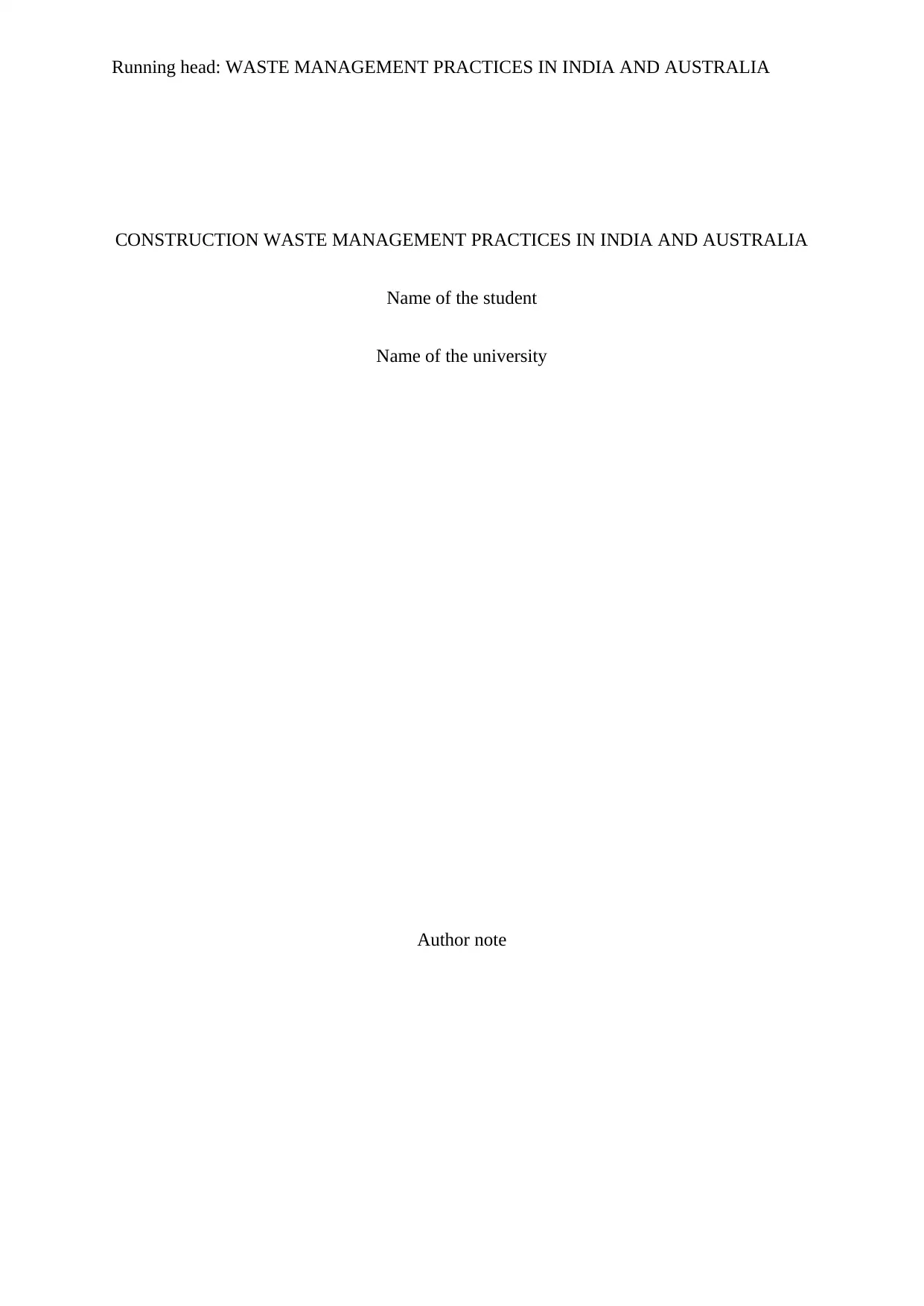
Running head: WASTE MANAGEMENT PRACTICES IN INDIA AND AUSTRALIA
CONSTRUCTION WASTE MANAGEMENT PRACTICES IN INDIA AND AUSTRALIA
Name of the student
Name of the university
Author note
CONSTRUCTION WASTE MANAGEMENT PRACTICES IN INDIA AND AUSTRALIA
Name of the student
Name of the university
Author note
Secure Best Marks with AI Grader
Need help grading? Try our AI Grader for instant feedback on your assignments.
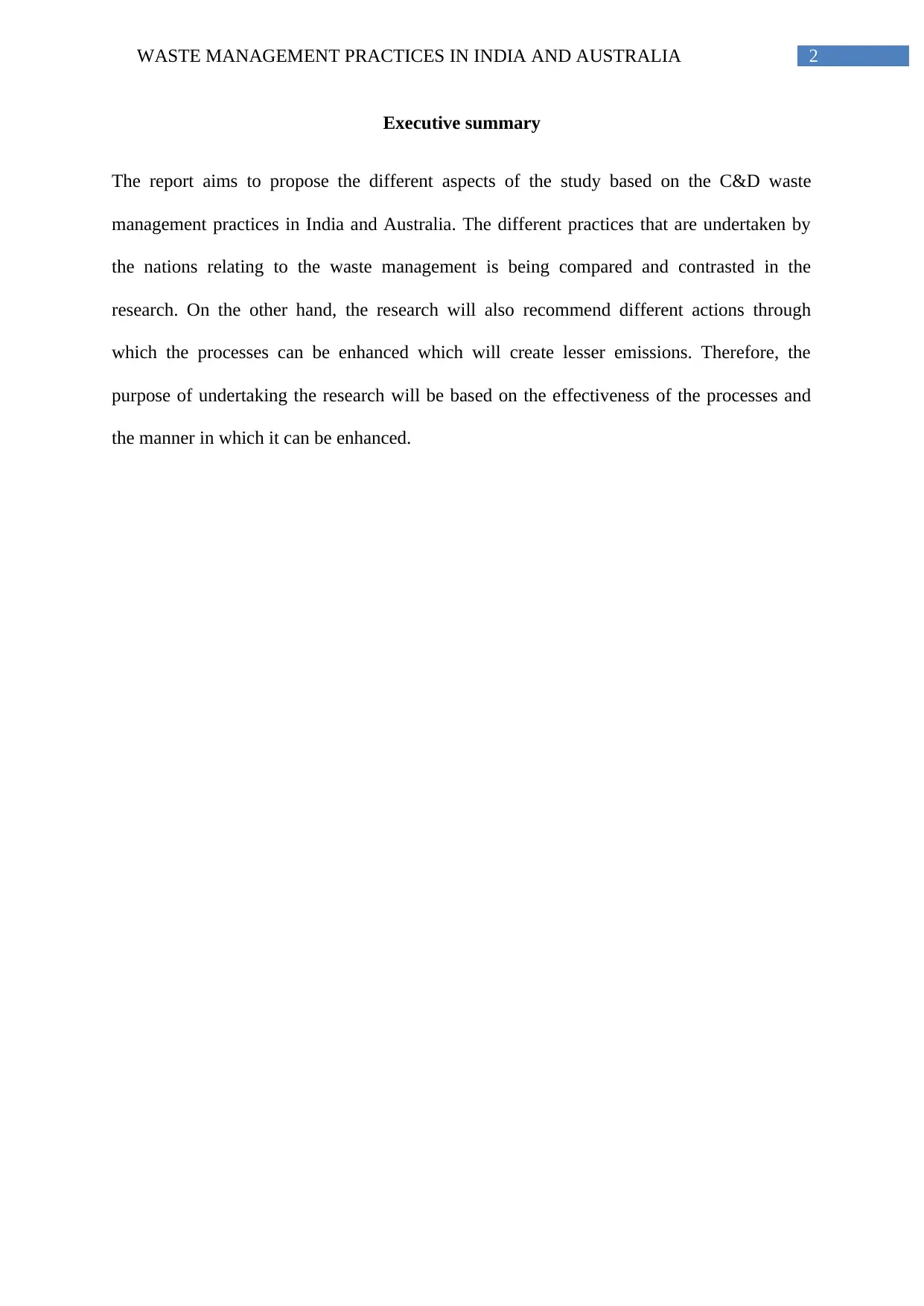
2WASTE MANAGEMENT PRACTICES IN INDIA AND AUSTRALIA
Executive summary
The report aims to propose the different aspects of the study based on the C&D waste
management practices in India and Australia. The different practices that are undertaken by
the nations relating to the waste management is being compared and contrasted in the
research. On the other hand, the research will also recommend different actions through
which the processes can be enhanced which will create lesser emissions. Therefore, the
purpose of undertaking the research will be based on the effectiveness of the processes and
the manner in which it can be enhanced.
Executive summary
The report aims to propose the different aspects of the study based on the C&D waste
management practices in India and Australia. The different practices that are undertaken by
the nations relating to the waste management is being compared and contrasted in the
research. On the other hand, the research will also recommend different actions through
which the processes can be enhanced which will create lesser emissions. Therefore, the
purpose of undertaking the research will be based on the effectiveness of the processes and
the manner in which it can be enhanced.
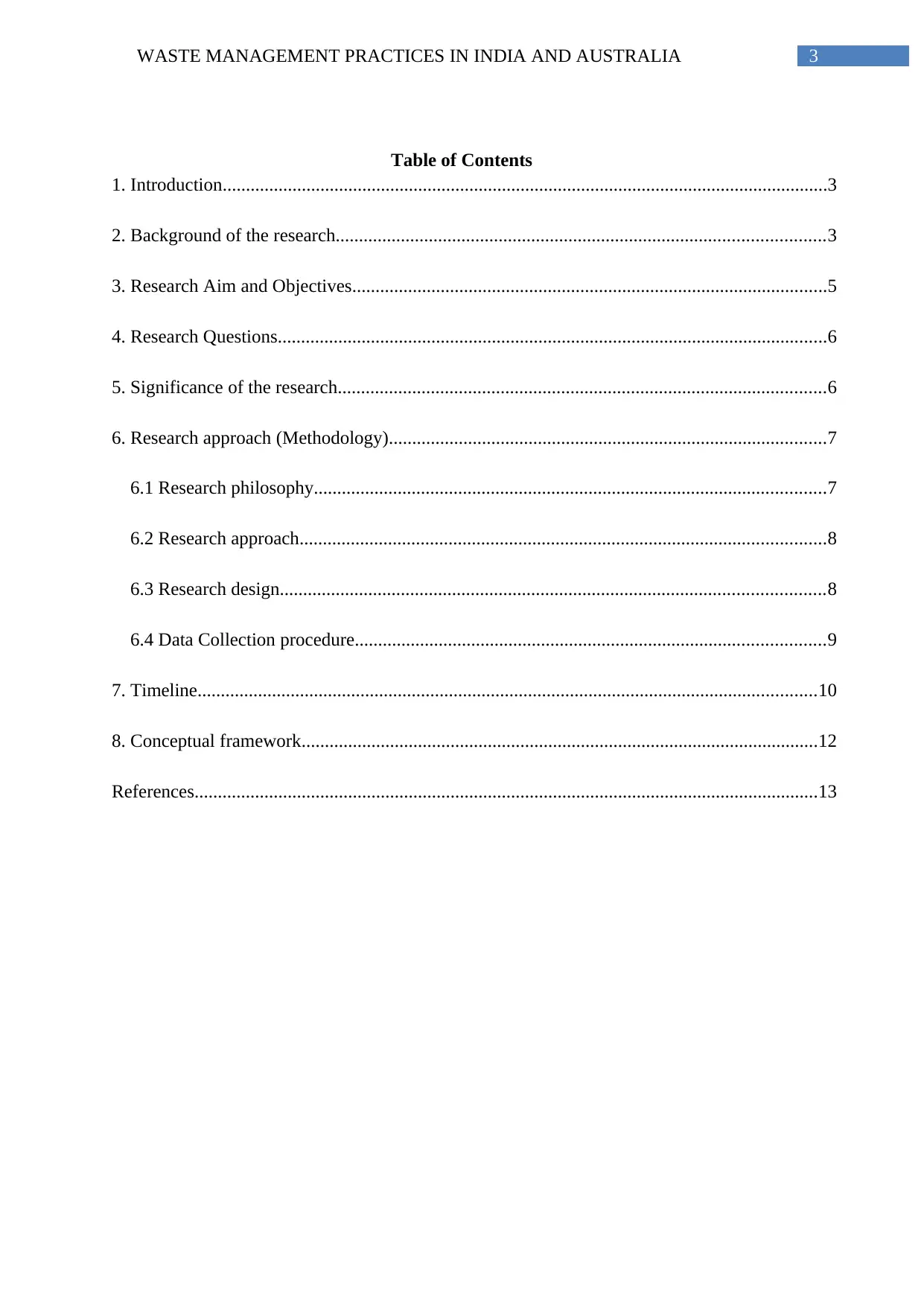
3WASTE MANAGEMENT PRACTICES IN INDIA AND AUSTRALIA
Table of Contents
1. Introduction..................................................................................................................................3
2. Background of the research.........................................................................................................3
3. Research Aim and Objectives......................................................................................................5
4. Research Questions......................................................................................................................6
5. Significance of the research.........................................................................................................6
6. Research approach (Methodology)..............................................................................................7
6.1 Research philosophy..............................................................................................................7
6.2 Research approach.................................................................................................................8
6.3 Research design.....................................................................................................................8
6.4 Data Collection procedure.....................................................................................................9
7. Timeline.....................................................................................................................................10
8. Conceptual framework...............................................................................................................12
References......................................................................................................................................13
Table of Contents
1. Introduction..................................................................................................................................3
2. Background of the research.........................................................................................................3
3. Research Aim and Objectives......................................................................................................5
4. Research Questions......................................................................................................................6
5. Significance of the research.........................................................................................................6
6. Research approach (Methodology)..............................................................................................7
6.1 Research philosophy..............................................................................................................7
6.2 Research approach.................................................................................................................8
6.3 Research design.....................................................................................................................8
6.4 Data Collection procedure.....................................................................................................9
7. Timeline.....................................................................................................................................10
8. Conceptual framework...............................................................................................................12
References......................................................................................................................................13
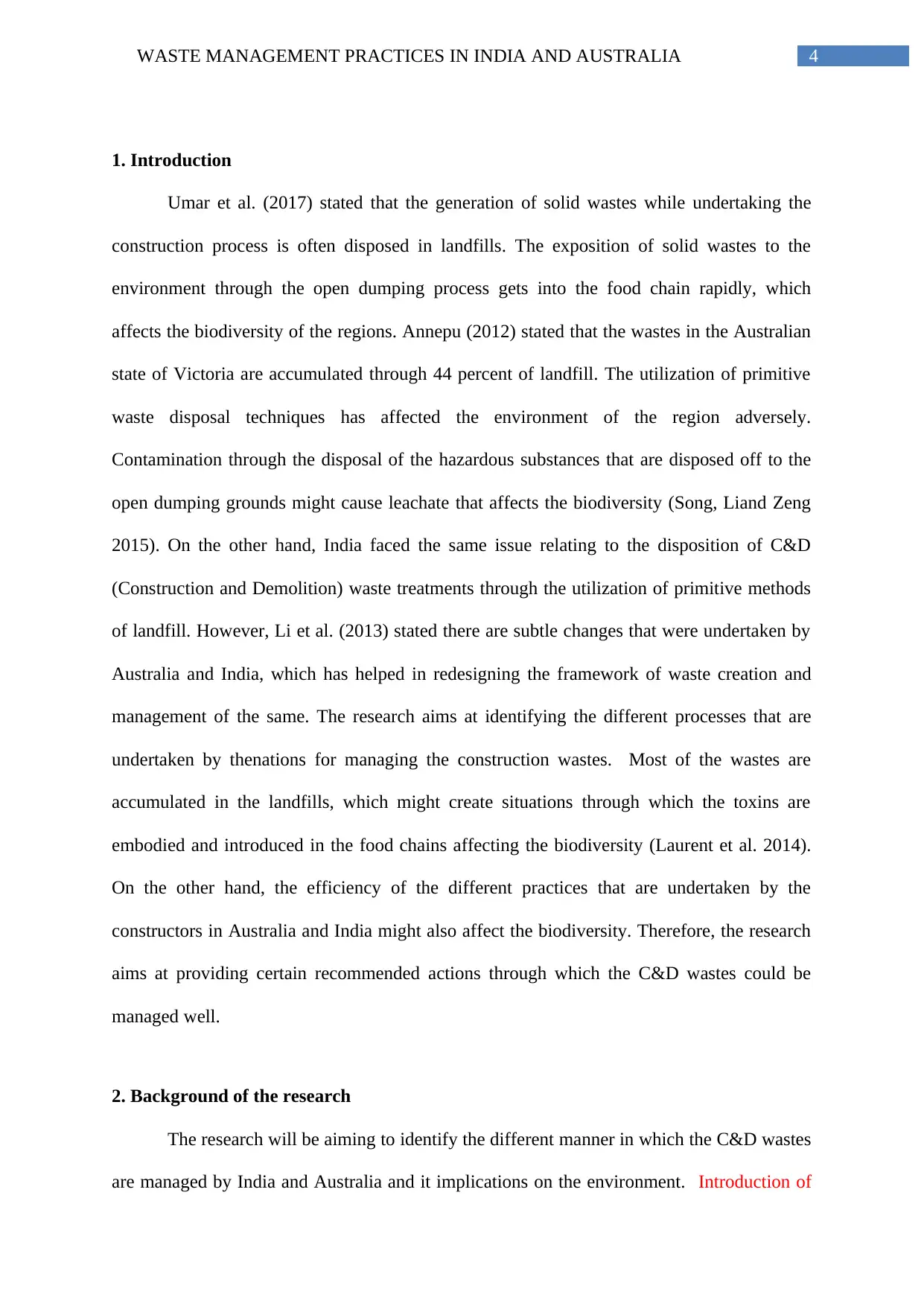
4WASTE MANAGEMENT PRACTICES IN INDIA AND AUSTRALIA
1. Introduction
Umar et al. (2017) stated that the generation of solid wastes while undertaking the
construction process is often disposed in landfills. The exposition of solid wastes to the
environment through the open dumping process gets into the food chain rapidly, which
affects the biodiversity of the regions. Annepu (2012) stated that the wastes in the Australian
state of Victoria are accumulated through 44 percent of landfill. The utilization of primitive
waste disposal techniques has affected the environment of the region adversely.
Contamination through the disposal of the hazardous substances that are disposed off to the
open dumping grounds might cause leachate that affects the biodiversity (Song, Liand Zeng
2015). On the other hand, India faced the same issue relating to the disposition of C&D
(Construction and Demolition) waste treatments through the utilization of primitive methods
of landfill. However, Li et al. (2013) stated there are subtle changes that were undertaken by
Australia and India, which has helped in redesigning the framework of waste creation and
management of the same. The research aims at identifying the different processes that are
undertaken by thenations for managing the construction wastes. Most of the wastes are
accumulated in the landfills, which might create situations through which the toxins are
embodied and introduced in the food chains affecting the biodiversity (Laurent et al. 2014).
On the other hand, the efficiency of the different practices that are undertaken by the
constructors in Australia and India might also affect the biodiversity. Therefore, the research
aims at providing certain recommended actions through which the C&D wastes could be
managed well.
2. Background of the research
The research will be aiming to identify the different manner in which the C&D wastes
are managed by India and Australia and it implications on the environment. Introduction of
1. Introduction
Umar et al. (2017) stated that the generation of solid wastes while undertaking the
construction process is often disposed in landfills. The exposition of solid wastes to the
environment through the open dumping process gets into the food chain rapidly, which
affects the biodiversity of the regions. Annepu (2012) stated that the wastes in the Australian
state of Victoria are accumulated through 44 percent of landfill. The utilization of primitive
waste disposal techniques has affected the environment of the region adversely.
Contamination through the disposal of the hazardous substances that are disposed off to the
open dumping grounds might cause leachate that affects the biodiversity (Song, Liand Zeng
2015). On the other hand, India faced the same issue relating to the disposition of C&D
(Construction and Demolition) waste treatments through the utilization of primitive methods
of landfill. However, Li et al. (2013) stated there are subtle changes that were undertaken by
Australia and India, which has helped in redesigning the framework of waste creation and
management of the same. The research aims at identifying the different processes that are
undertaken by thenations for managing the construction wastes. Most of the wastes are
accumulated in the landfills, which might create situations through which the toxins are
embodied and introduced in the food chains affecting the biodiversity (Laurent et al. 2014).
On the other hand, the efficiency of the different practices that are undertaken by the
constructors in Australia and India might also affect the biodiversity. Therefore, the research
aims at providing certain recommended actions through which the C&D wastes could be
managed well.
2. Background of the research
The research will be aiming to identify the different manner in which the C&D wastes
are managed by India and Australia and it implications on the environment. Introduction of
Secure Best Marks with AI Grader
Need help grading? Try our AI Grader for instant feedback on your assignments.
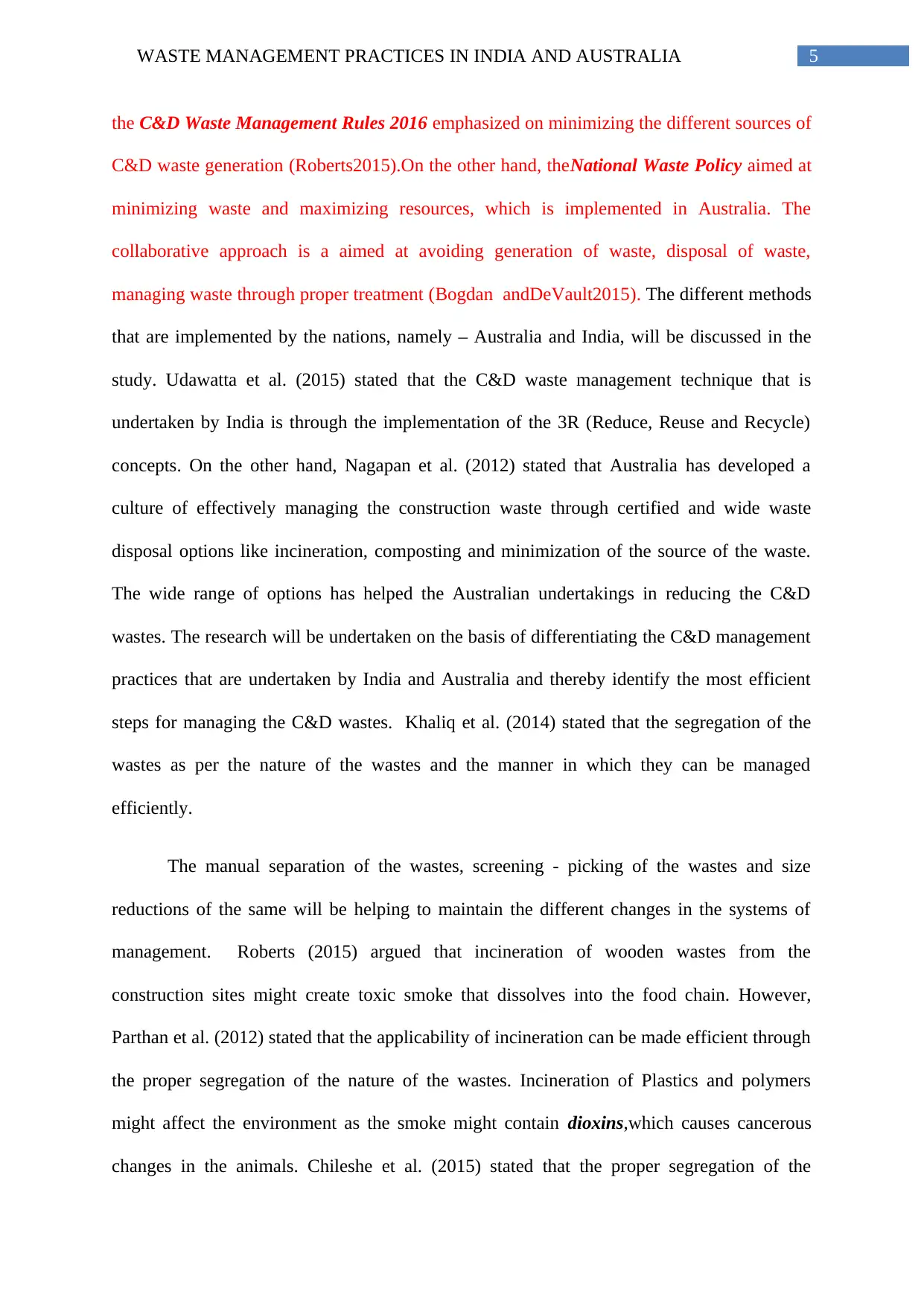
5WASTE MANAGEMENT PRACTICES IN INDIA AND AUSTRALIA
the C&D Waste Management Rules 2016 emphasized on minimizing the different sources of
C&D waste generation (Roberts2015).On the other hand, theNational Waste Policy aimed at
minimizing waste and maximizing resources, which is implemented in Australia. The
collaborative approach is a aimed at avoiding generation of waste, disposal of waste,
managing waste through proper treatment (Bogdan andDeVault2015). The different methods
that are implemented by the nations, namely – Australia and India, will be discussed in the
study. Udawatta et al. (2015) stated that the C&D waste management technique that is
undertaken by India is through the implementation of the 3R (Reduce, Reuse and Recycle)
concepts. On the other hand, Nagapan et al. (2012) stated that Australia has developed a
culture of effectively managing the construction waste through certified and wide waste
disposal options like incineration, composting and minimization of the source of the waste.
The wide range of options has helped the Australian undertakings in reducing the C&D
wastes. The research will be undertaken on the basis of differentiating the C&D management
practices that are undertaken by India and Australia and thereby identify the most efficient
steps for managing the C&D wastes. Khaliq et al. (2014) stated that the segregation of the
wastes as per the nature of the wastes and the manner in which they can be managed
efficiently.
The manual separation of the wastes, screening - picking of the wastes and size
reductions of the same will be helping to maintain the different changes in the systems of
management. Roberts (2015) argued that incineration of wooden wastes from the
construction sites might create toxic smoke that dissolves into the food chain. However,
Parthan et al. (2012) stated that the applicability of incineration can be made efficient through
the proper segregation of the nature of the wastes. Incineration of Plastics and polymers
might affect the environment as the smoke might contain dioxins,which causes cancerous
changes in the animals. Chileshe et al. (2015) stated that the proper segregation of the
the C&D Waste Management Rules 2016 emphasized on minimizing the different sources of
C&D waste generation (Roberts2015).On the other hand, theNational Waste Policy aimed at
minimizing waste and maximizing resources, which is implemented in Australia. The
collaborative approach is a aimed at avoiding generation of waste, disposal of waste,
managing waste through proper treatment (Bogdan andDeVault2015). The different methods
that are implemented by the nations, namely – Australia and India, will be discussed in the
study. Udawatta et al. (2015) stated that the C&D waste management technique that is
undertaken by India is through the implementation of the 3R (Reduce, Reuse and Recycle)
concepts. On the other hand, Nagapan et al. (2012) stated that Australia has developed a
culture of effectively managing the construction waste through certified and wide waste
disposal options like incineration, composting and minimization of the source of the waste.
The wide range of options has helped the Australian undertakings in reducing the C&D
wastes. The research will be undertaken on the basis of differentiating the C&D management
practices that are undertaken by India and Australia and thereby identify the most efficient
steps for managing the C&D wastes. Khaliq et al. (2014) stated that the segregation of the
wastes as per the nature of the wastes and the manner in which they can be managed
efficiently.
The manual separation of the wastes, screening - picking of the wastes and size
reductions of the same will be helping to maintain the different changes in the systems of
management. Roberts (2015) argued that incineration of wooden wastes from the
construction sites might create toxic smoke that dissolves into the food chain. However,
Parthan et al. (2012) stated that the applicability of incineration can be made efficient through
the proper segregation of the nature of the wastes. Incineration of Plastics and polymers
might affect the environment as the smoke might contain dioxins,which causes cancerous
changes in the animals. Chileshe et al. (2015) stated that the proper segregation of the
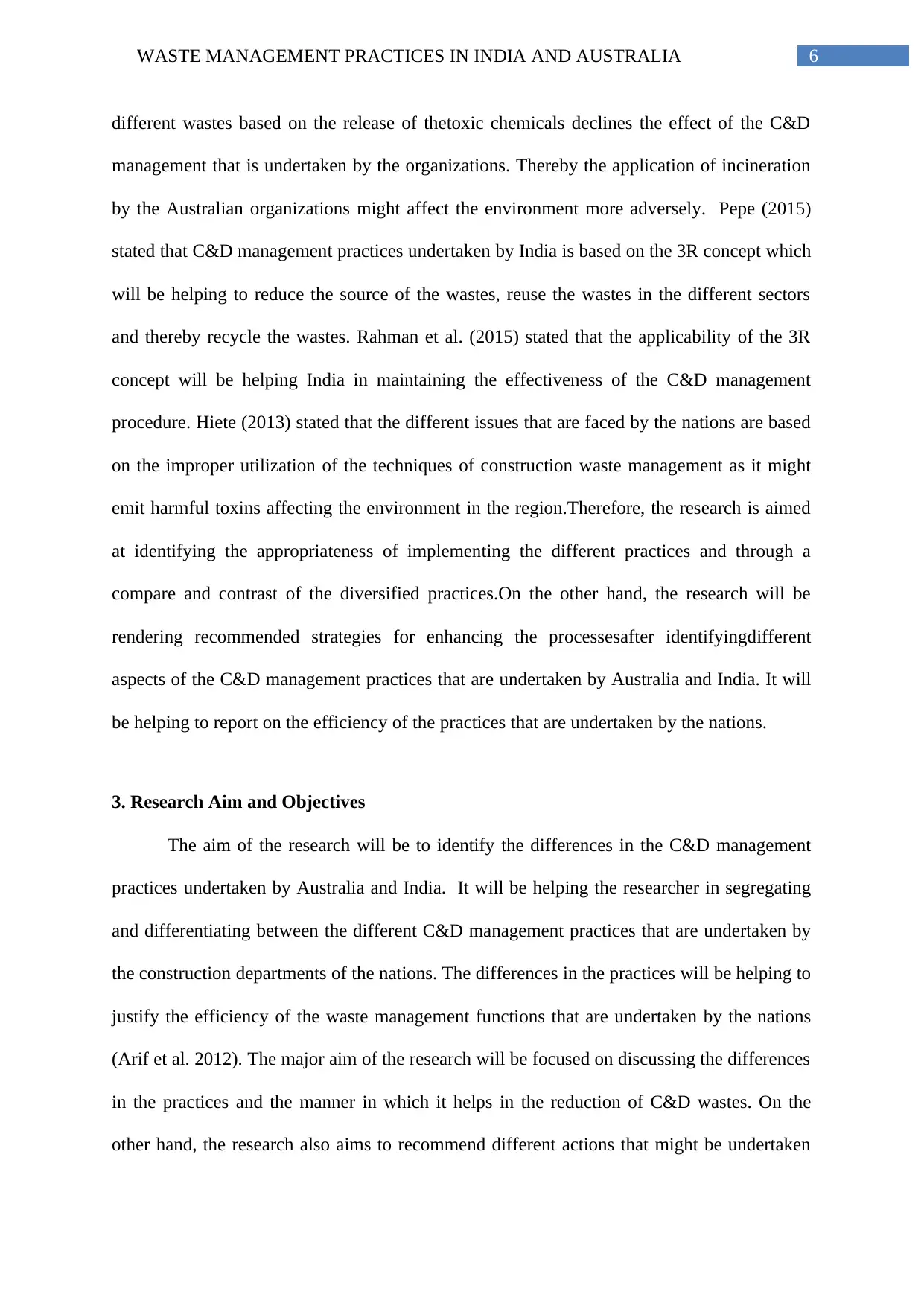
6WASTE MANAGEMENT PRACTICES IN INDIA AND AUSTRALIA
different wastes based on the release of thetoxic chemicals declines the effect of the C&D
management that is undertaken by the organizations. Thereby the application of incineration
by the Australian organizations might affect the environment more adversely. Pepe (2015)
stated that C&D management practices undertaken by India is based on the 3R concept which
will be helping to reduce the source of the wastes, reuse the wastes in the different sectors
and thereby recycle the wastes. Rahman et al. (2015) stated that the applicability of the 3R
concept will be helping India in maintaining the effectiveness of the C&D management
procedure. Hiete (2013) stated that the different issues that are faced by the nations are based
on the improper utilization of the techniques of construction waste management as it might
emit harmful toxins affecting the environment in the region.Therefore, the research is aimed
at identifying the appropriateness of implementing the different practices and through a
compare and contrast of the diversified practices.On the other hand, the research will be
rendering recommended strategies for enhancing the processesafter identifyingdifferent
aspects of the C&D management practices that are undertaken by Australia and India. It will
be helping to report on the efficiency of the practices that are undertaken by the nations.
3. Research Aim and Objectives
The aim of the research will be to identify the differences in the C&D management
practices undertaken by Australia and India. It will be helping the researcher in segregating
and differentiating between the different C&D management practices that are undertaken by
the construction departments of the nations. The differences in the practices will be helping to
justify the efficiency of the waste management functions that are undertaken by the nations
(Arif et al. 2012). The major aim of the research will be focused on discussing the differences
in the practices and the manner in which it helps in the reduction of C&D wastes. On the
other hand, the research also aims to recommend different actions that might be undertaken
different wastes based on the release of thetoxic chemicals declines the effect of the C&D
management that is undertaken by the organizations. Thereby the application of incineration
by the Australian organizations might affect the environment more adversely. Pepe (2015)
stated that C&D management practices undertaken by India is based on the 3R concept which
will be helping to reduce the source of the wastes, reuse the wastes in the different sectors
and thereby recycle the wastes. Rahman et al. (2015) stated that the applicability of the 3R
concept will be helping India in maintaining the effectiveness of the C&D management
procedure. Hiete (2013) stated that the different issues that are faced by the nations are based
on the improper utilization of the techniques of construction waste management as it might
emit harmful toxins affecting the environment in the region.Therefore, the research is aimed
at identifying the appropriateness of implementing the different practices and through a
compare and contrast of the diversified practices.On the other hand, the research will be
rendering recommended strategies for enhancing the processesafter identifyingdifferent
aspects of the C&D management practices that are undertaken by Australia and India. It will
be helping to report on the efficiency of the practices that are undertaken by the nations.
3. Research Aim and Objectives
The aim of the research will be to identify the differences in the C&D management
practices undertaken by Australia and India. It will be helping the researcher in segregating
and differentiating between the different C&D management practices that are undertaken by
the construction departments of the nations. The differences in the practices will be helping to
justify the efficiency of the waste management functions that are undertaken by the nations
(Arif et al. 2012). The major aim of the research will be focused on discussing the differences
in the practices and the manner in which it helps in the reduction of C&D wastes. On the
other hand, the research also aims to recommend different actions that might be undertaken
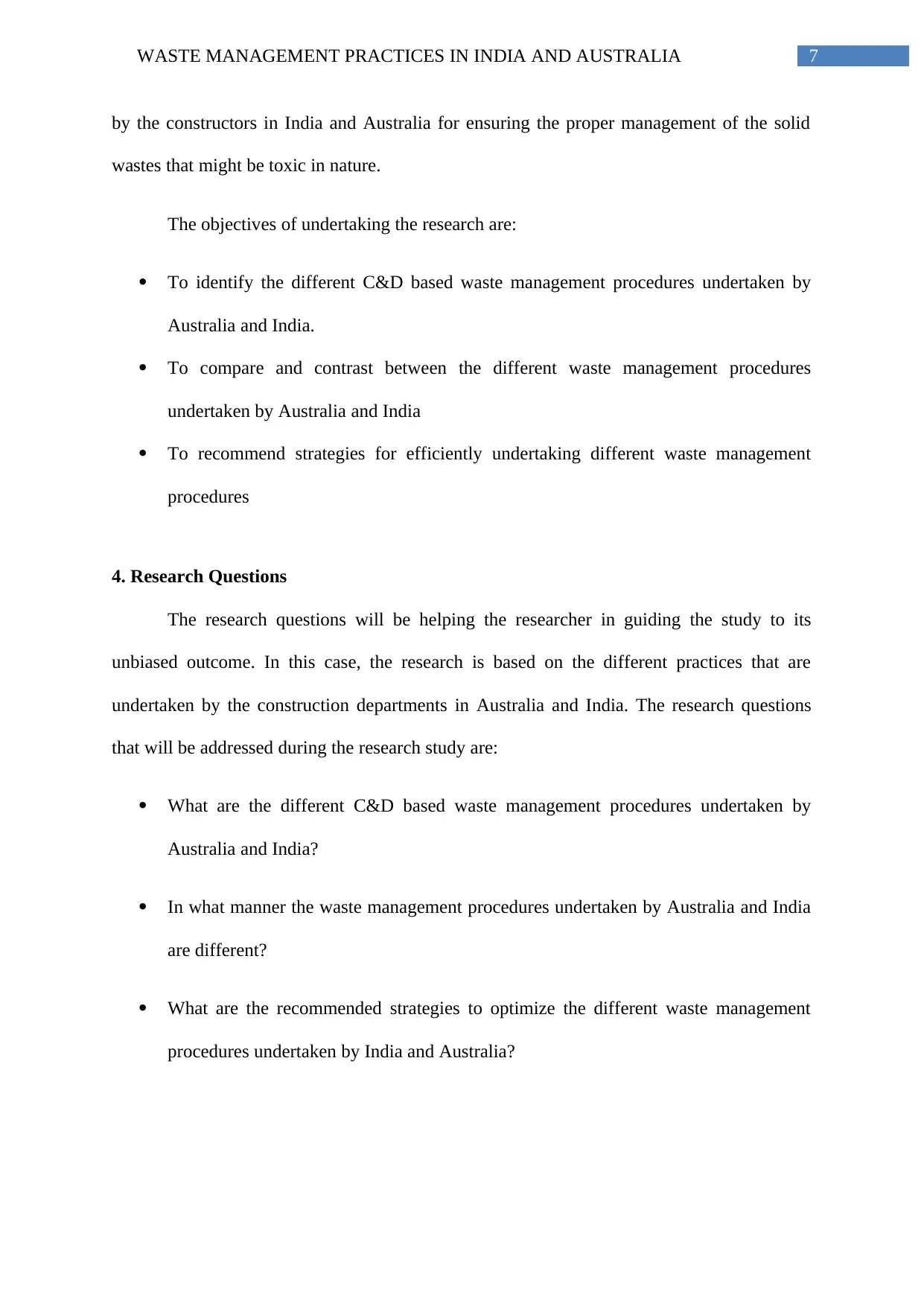
7WASTE MANAGEMENT PRACTICES IN INDIA AND AUSTRALIA
by the constructors in India and Australia for ensuring the proper management of the solid
wastes that might be toxic in nature.
The objectives of undertaking the research are:
To identify the different C&D based waste management procedures undertaken by
Australia and India.
To compare and contrast between the different waste management procedures
undertaken by Australia and India
To recommend strategies for efficiently undertaking different waste management
procedures
4. Research Questions
The research questions will be helping the researcher in guiding the study to its
unbiased outcome. In this case, the research is based on the different practices that are
undertaken by the construction departments in Australia and India. The research questions
that will be addressed during the research study are:
What are the different C&D based waste management procedures undertaken by
Australia and India?
In what manner the waste management procedures undertaken by Australia and India
are different?
What are the recommended strategies to optimize the different waste management
procedures undertaken by India and Australia?
by the constructors in India and Australia for ensuring the proper management of the solid
wastes that might be toxic in nature.
The objectives of undertaking the research are:
To identify the different C&D based waste management procedures undertaken by
Australia and India.
To compare and contrast between the different waste management procedures
undertaken by Australia and India
To recommend strategies for efficiently undertaking different waste management
procedures
4. Research Questions
The research questions will be helping the researcher in guiding the study to its
unbiased outcome. In this case, the research is based on the different practices that are
undertaken by the construction departments in Australia and India. The research questions
that will be addressed during the research study are:
What are the different C&D based waste management procedures undertaken by
Australia and India?
In what manner the waste management procedures undertaken by Australia and India
are different?
What are the recommended strategies to optimize the different waste management
procedures undertaken by India and Australia?
Paraphrase This Document
Need a fresh take? Get an instant paraphrase of this document with our AI Paraphraser
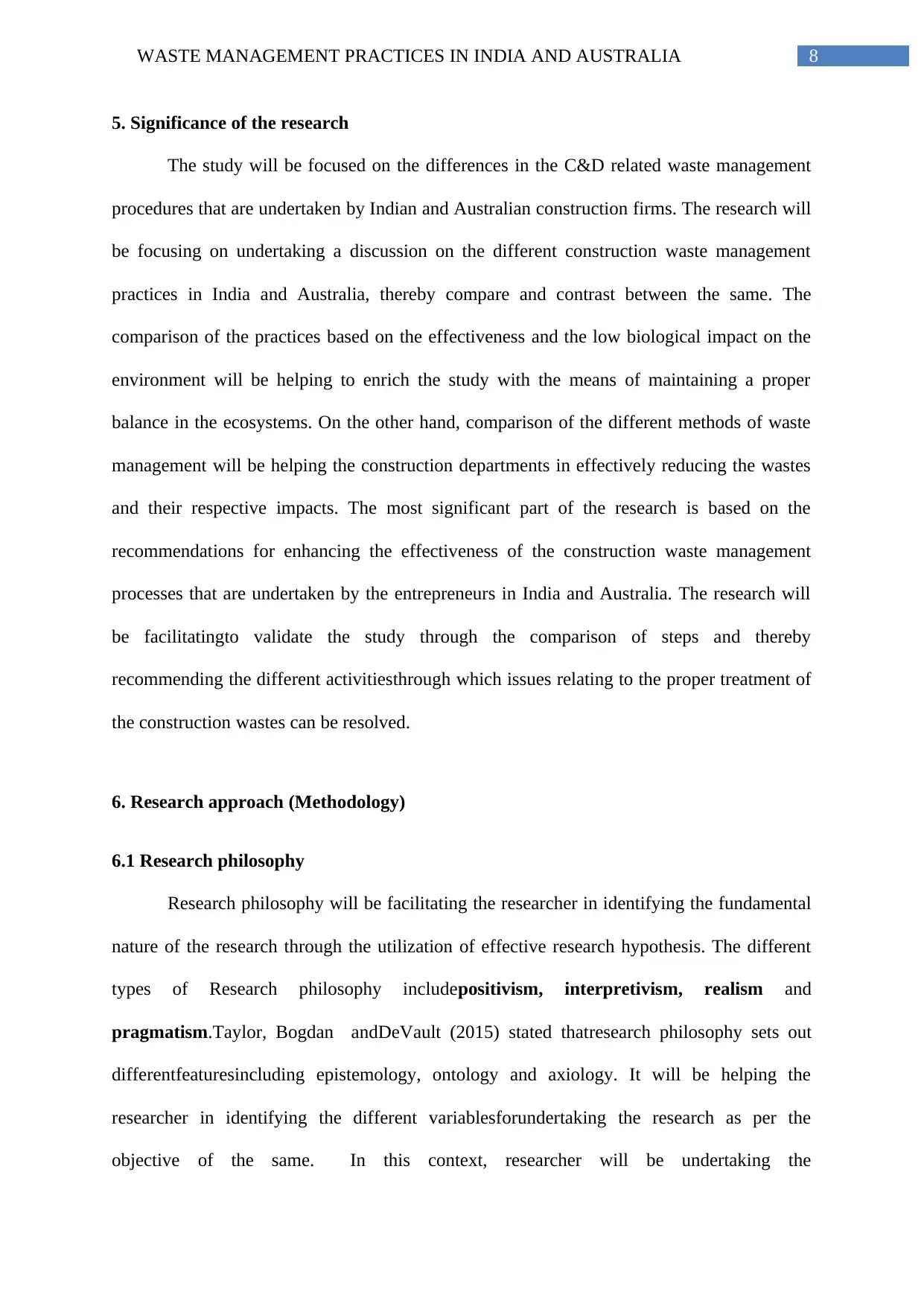
8WASTE MANAGEMENT PRACTICES IN INDIA AND AUSTRALIA
5. Significance of the research
The study will be focused on the differences in the C&D related waste management
procedures that are undertaken by Indian and Australian construction firms. The research will
be focusing on undertaking a discussion on the different construction waste management
practices in India and Australia, thereby compare and contrast between the same. The
comparison of the practices based on the effectiveness and the low biological impact on the
environment will be helping to enrich the study with the means of maintaining a proper
balance in the ecosystems. On the other hand, comparison of the different methods of waste
management will be helping the construction departments in effectively reducing the wastes
and their respective impacts. The most significant part of the research is based on the
recommendations for enhancing the effectiveness of the construction waste management
processes that are undertaken by the entrepreneurs in India and Australia. The research will
be facilitatingto validate the study through the comparison of steps and thereby
recommending the different activitiesthrough which issues relating to the proper treatment of
the construction wastes can be resolved.
6. Research approach (Methodology)
6.1 Research philosophy
Research philosophy will be facilitating the researcher in identifying the fundamental
nature of the research through the utilization of effective research hypothesis. The different
types of Research philosophy includepositivism, interpretivism, realism and
pragmatism.Taylor, Bogdan andDeVault (2015) stated thatresearch philosophy sets out
differentfeaturesincluding epistemology, ontology and axiology. It will be helping the
researcher in identifying the different variablesforundertaking the research as per the
objective of the same. In this context, researcher will be undertaking the
5. Significance of the research
The study will be focused on the differences in the C&D related waste management
procedures that are undertaken by Indian and Australian construction firms. The research will
be focusing on undertaking a discussion on the different construction waste management
practices in India and Australia, thereby compare and contrast between the same. The
comparison of the practices based on the effectiveness and the low biological impact on the
environment will be helping to enrich the study with the means of maintaining a proper
balance in the ecosystems. On the other hand, comparison of the different methods of waste
management will be helping the construction departments in effectively reducing the wastes
and their respective impacts. The most significant part of the research is based on the
recommendations for enhancing the effectiveness of the construction waste management
processes that are undertaken by the entrepreneurs in India and Australia. The research will
be facilitatingto validate the study through the comparison of steps and thereby
recommending the different activitiesthrough which issues relating to the proper treatment of
the construction wastes can be resolved.
6. Research approach (Methodology)
6.1 Research philosophy
Research philosophy will be facilitating the researcher in identifying the fundamental
nature of the research through the utilization of effective research hypothesis. The different
types of Research philosophy includepositivism, interpretivism, realism and
pragmatism.Taylor, Bogdan andDeVault (2015) stated thatresearch philosophy sets out
differentfeaturesincluding epistemology, ontology and axiology. It will be helping the
researcher in identifying the different variablesforundertaking the research as per the
objective of the same. In this context, researcher will be undertaking the
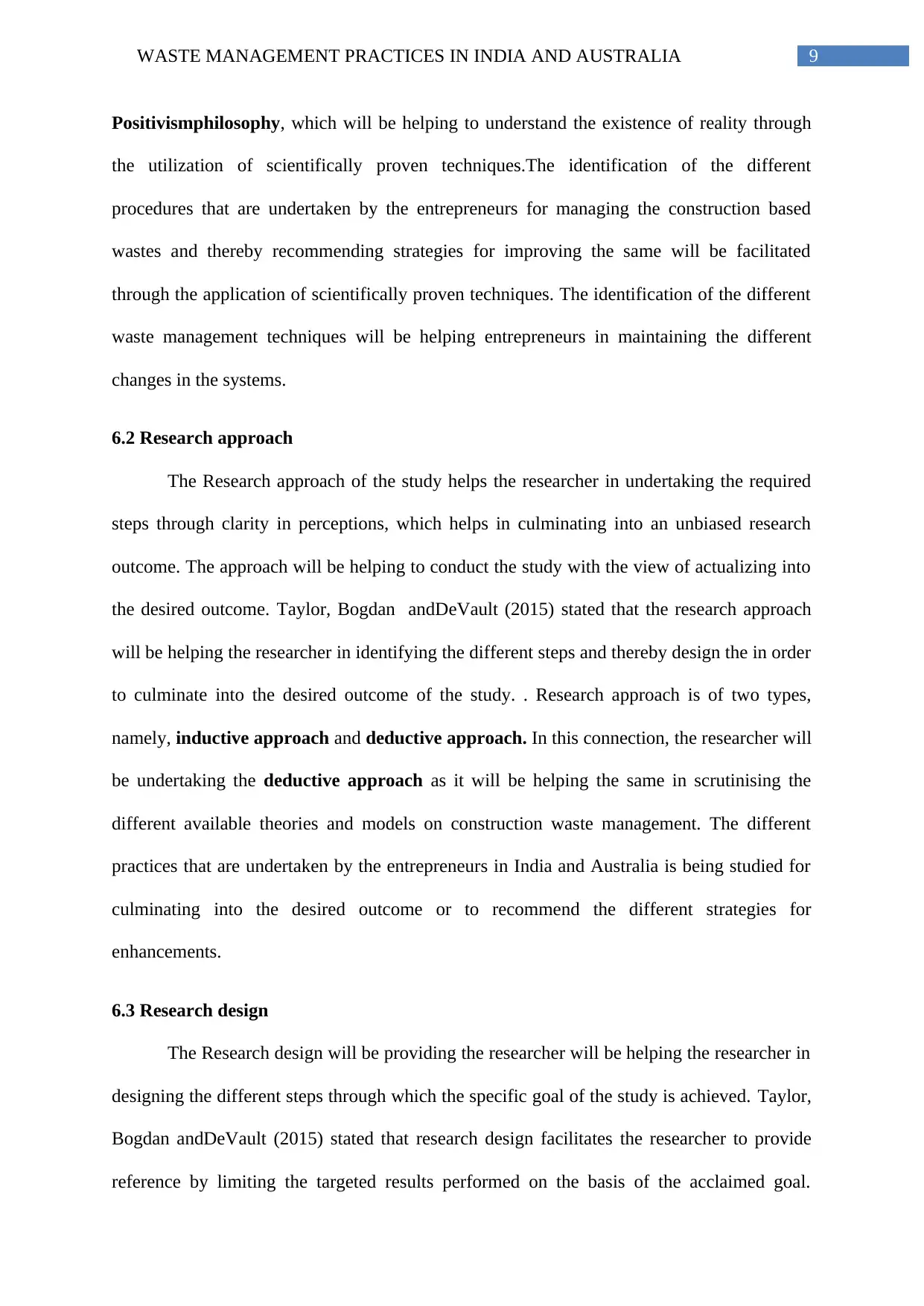
9WASTE MANAGEMENT PRACTICES IN INDIA AND AUSTRALIA
Positivismphilosophy, which will be helping to understand the existence of reality through
the utilization of scientifically proven techniques.The identification of the different
procedures that are undertaken by the entrepreneurs for managing the construction based
wastes and thereby recommending strategies for improving the same will be facilitated
through the application of scientifically proven techniques. The identification of the different
waste management techniques will be helping entrepreneurs in maintaining the different
changes in the systems.
6.2 Research approach
The Research approach of the study helps the researcher in undertaking the required
steps through clarity in perceptions, which helps in culminating into an unbiased research
outcome. The approach will be helping to conduct the study with the view of actualizing into
the desired outcome. Taylor, Bogdan andDeVault (2015) stated that the research approach
will be helping the researcher in identifying the different steps and thereby design the in order
to culminate into the desired outcome of the study. . Research approach is of two types,
namely, inductive approach and deductive approach. In this connection, the researcher will
be undertaking the deductive approach as it will be helping the same in scrutinising the
different available theories and models on construction waste management. The different
practices that are undertaken by the entrepreneurs in India and Australia is being studied for
culminating into the desired outcome or to recommend the different strategies for
enhancements.
6.3 Research design
The Research design will be providing the researcher will be helping the researcher in
designing the different steps through which the specific goal of the study is achieved. Taylor,
Bogdan andDeVault (2015) stated that research design facilitates the researcher to provide
reference by limiting the targeted results performed on the basis of the acclaimed goal.
Positivismphilosophy, which will be helping to understand the existence of reality through
the utilization of scientifically proven techniques.The identification of the different
procedures that are undertaken by the entrepreneurs for managing the construction based
wastes and thereby recommending strategies for improving the same will be facilitated
through the application of scientifically proven techniques. The identification of the different
waste management techniques will be helping entrepreneurs in maintaining the different
changes in the systems.
6.2 Research approach
The Research approach of the study helps the researcher in undertaking the required
steps through clarity in perceptions, which helps in culminating into an unbiased research
outcome. The approach will be helping to conduct the study with the view of actualizing into
the desired outcome. Taylor, Bogdan andDeVault (2015) stated that the research approach
will be helping the researcher in identifying the different steps and thereby design the in order
to culminate into the desired outcome of the study. . Research approach is of two types,
namely, inductive approach and deductive approach. In this connection, the researcher will
be undertaking the deductive approach as it will be helping the same in scrutinising the
different available theories and models on construction waste management. The different
practices that are undertaken by the entrepreneurs in India and Australia is being studied for
culminating into the desired outcome or to recommend the different strategies for
enhancements.
6.3 Research design
The Research design will be providing the researcher will be helping the researcher in
designing the different steps through which the specific goal of the study is achieved. Taylor,
Bogdan andDeVault (2015) stated that research design facilitates the researcher to provide
reference by limiting the targeted results performed on the basis of the acclaimed goal.
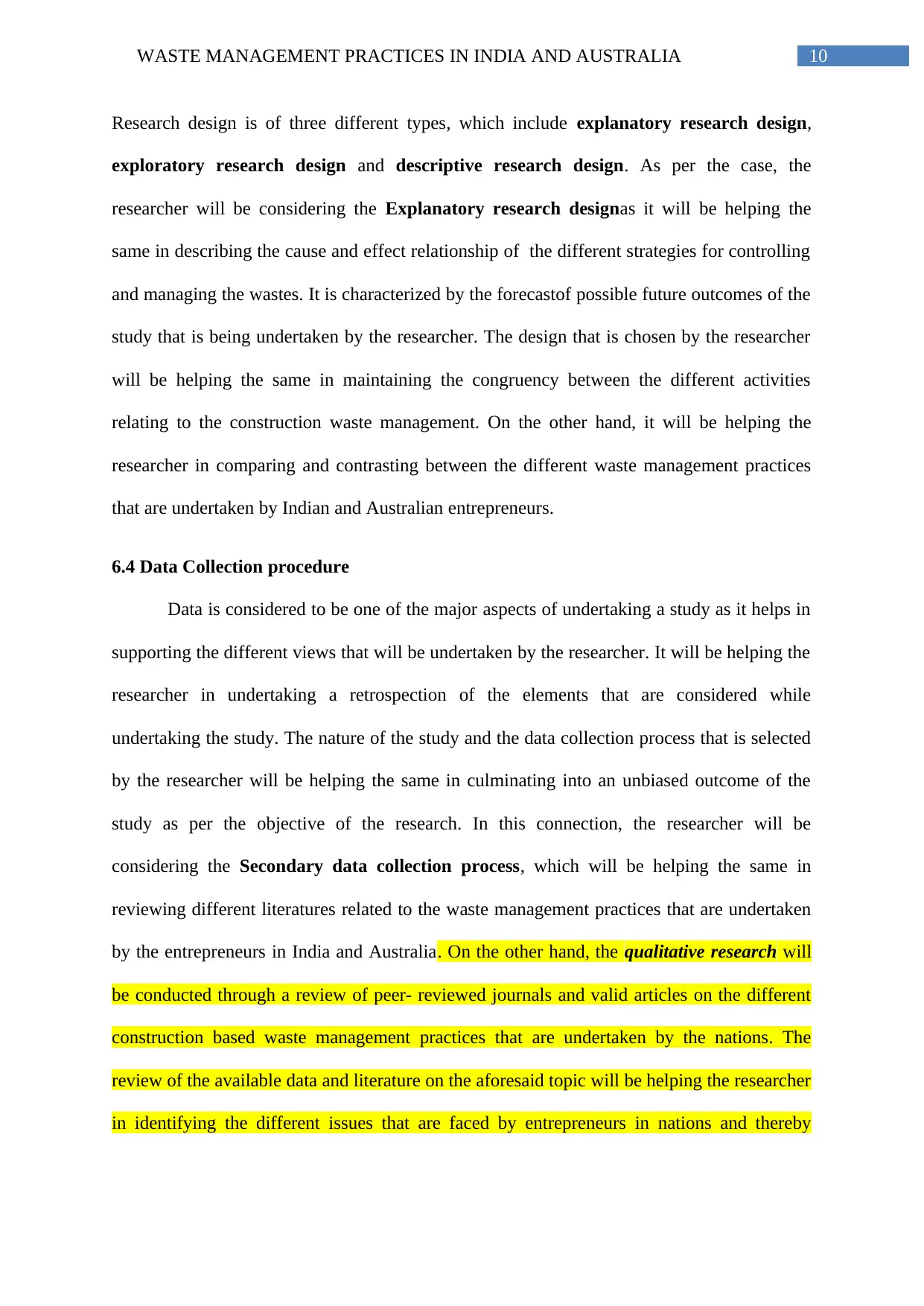
10WASTE MANAGEMENT PRACTICES IN INDIA AND AUSTRALIA
Research design is of three different types, which include explanatory research design,
exploratory research design and descriptive research design. As per the case, the
researcher will be considering the Explanatory research designas it will be helping the
same in describing the cause and effect relationship of the different strategies for controlling
and managing the wastes. It is characterized by the forecastof possible future outcomes of the
study that is being undertaken by the researcher. The design that is chosen by the researcher
will be helping the same in maintaining the congruency between the different activities
relating to the construction waste management. On the other hand, it will be helping the
researcher in comparing and contrasting between the different waste management practices
that are undertaken by Indian and Australian entrepreneurs.
6.4 Data Collection procedure
Data is considered to be one of the major aspects of undertaking a study as it helps in
supporting the different views that will be undertaken by the researcher. It will be helping the
researcher in undertaking a retrospection of the elements that are considered while
undertaking the study. The nature of the study and the data collection process that is selected
by the researcher will be helping the same in culminating into an unbiased outcome of the
study as per the objective of the research. In this connection, the researcher will be
considering the Secondary data collection process, which will be helping the same in
reviewing different literatures related to the waste management practices that are undertaken
by the entrepreneurs in India and Australia. On the other hand, the qualitative research will
be conducted through a review of peer- reviewed journals and valid articles on the different
construction based waste management practices that are undertaken by the nations. The
review of the available data and literature on the aforesaid topic will be helping the researcher
in identifying the different issues that are faced by entrepreneurs in nations and thereby
Research design is of three different types, which include explanatory research design,
exploratory research design and descriptive research design. As per the case, the
researcher will be considering the Explanatory research designas it will be helping the
same in describing the cause and effect relationship of the different strategies for controlling
and managing the wastes. It is characterized by the forecastof possible future outcomes of the
study that is being undertaken by the researcher. The design that is chosen by the researcher
will be helping the same in maintaining the congruency between the different activities
relating to the construction waste management. On the other hand, it will be helping the
researcher in comparing and contrasting between the different waste management practices
that are undertaken by Indian and Australian entrepreneurs.
6.4 Data Collection procedure
Data is considered to be one of the major aspects of undertaking a study as it helps in
supporting the different views that will be undertaken by the researcher. It will be helping the
researcher in undertaking a retrospection of the elements that are considered while
undertaking the study. The nature of the study and the data collection process that is selected
by the researcher will be helping the same in culminating into an unbiased outcome of the
study as per the objective of the research. In this connection, the researcher will be
considering the Secondary data collection process, which will be helping the same in
reviewing different literatures related to the waste management practices that are undertaken
by the entrepreneurs in India and Australia. On the other hand, the qualitative research will
be conducted through a review of peer- reviewed journals and valid articles on the different
construction based waste management practices that are undertaken by the nations. The
review of the available data and literature on the aforesaid topic will be helping the researcher
in identifying the different issues that are faced by entrepreneurs in nations and thereby
Secure Best Marks with AI Grader
Need help grading? Try our AI Grader for instant feedback on your assignments.
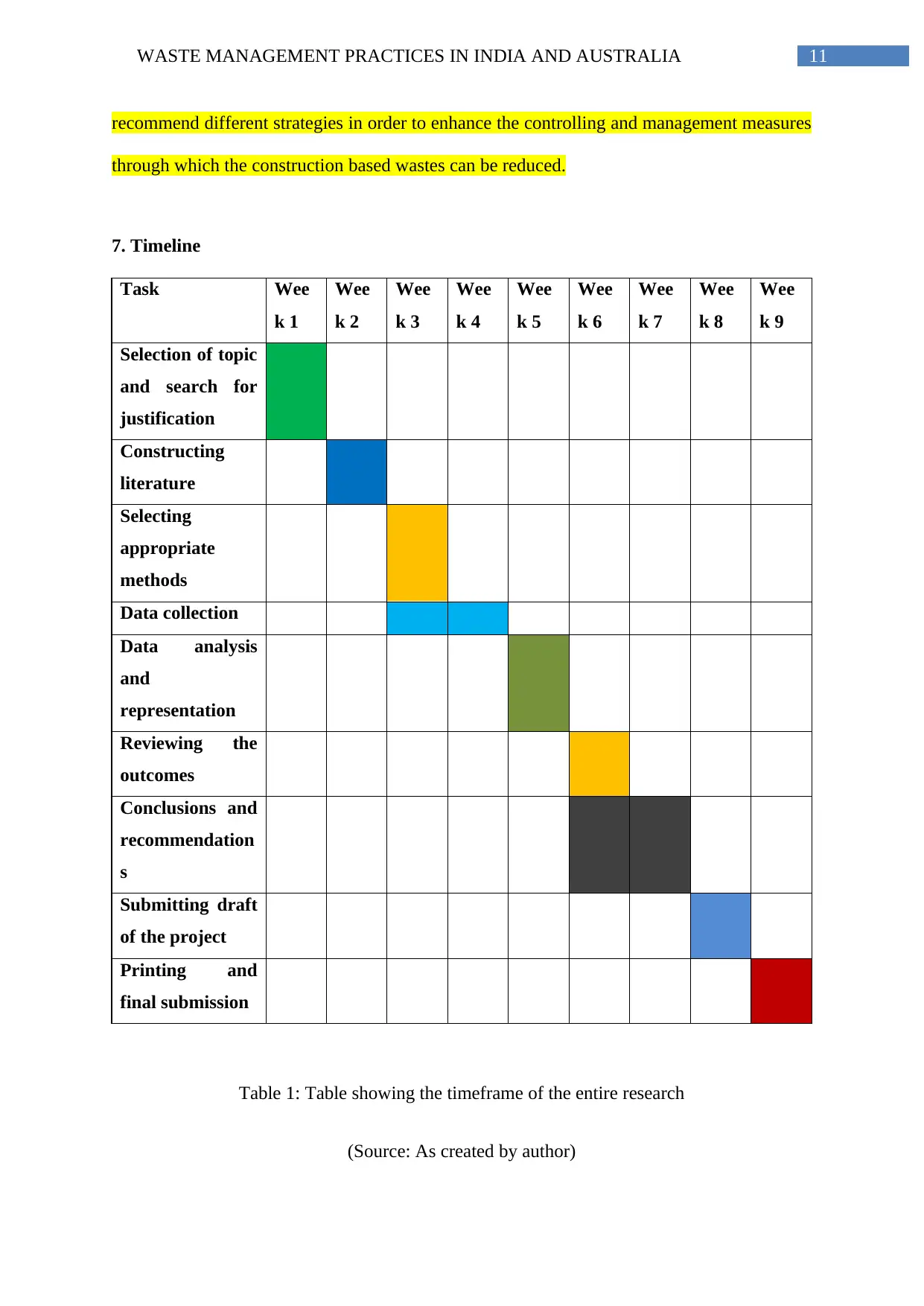
11WASTE MANAGEMENT PRACTICES IN INDIA AND AUSTRALIA
recommend different strategies in order to enhance the controlling and management measures
through which the construction based wastes can be reduced.
7. Timeline
Task Wee
k 1
Wee
k 2
Wee
k 3
Wee
k 4
Wee
k 5
Wee
k 6
Wee
k 7
Wee
k 8
Wee
k 9
Selection of topic
and search for
justification
Constructing
literature
Selecting
appropriate
methods
Data collection
Data analysis
and
representation
Reviewing the
outcomes
Conclusions and
recommendation
s
Submitting draft
of the project
Printing and
final submission
Table 1: Table showing the timeframe of the entire research
(Source: As created by author)
recommend different strategies in order to enhance the controlling and management measures
through which the construction based wastes can be reduced.
7. Timeline
Task Wee
k 1
Wee
k 2
Wee
k 3
Wee
k 4
Wee
k 5
Wee
k 6
Wee
k 7
Wee
k 8
Wee
k 9
Selection of topic
and search for
justification
Constructing
literature
Selecting
appropriate
methods
Data collection
Data analysis
and
representation
Reviewing the
outcomes
Conclusions and
recommendation
s
Submitting draft
of the project
Printing and
final submission
Table 1: Table showing the timeframe of the entire research
(Source: As created by author)
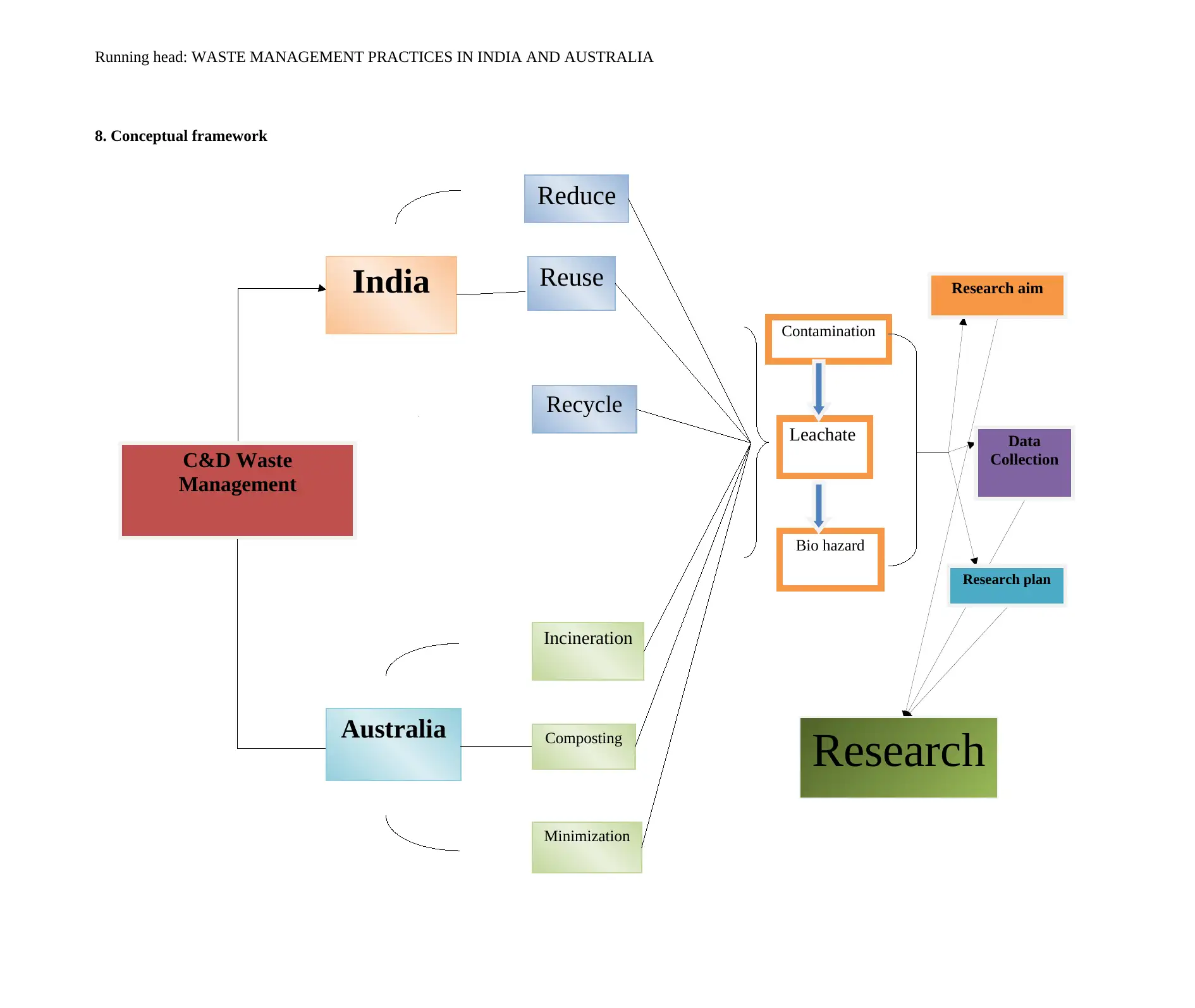
C&D Waste
Management
India
Australia
Reduce
Reuse
Recycle
Incineration
Composting
Minimization
Leachate
Bio hazard
Contamination
Research aim
Data
Collection
Research plan
Research
Running head: WASTE MANAGEMENT PRACTICES IN INDIA AND AUSTRALIA
8. Conceptual framework
Management
India
Australia
Reduce
Reuse
Recycle
Incineration
Composting
Minimization
Leachate
Bio hazard
Contamination
Research aim
Data
Collection
Research plan
Research
Running head: WASTE MANAGEMENT PRACTICES IN INDIA AND AUSTRALIA
8. Conceptual framework
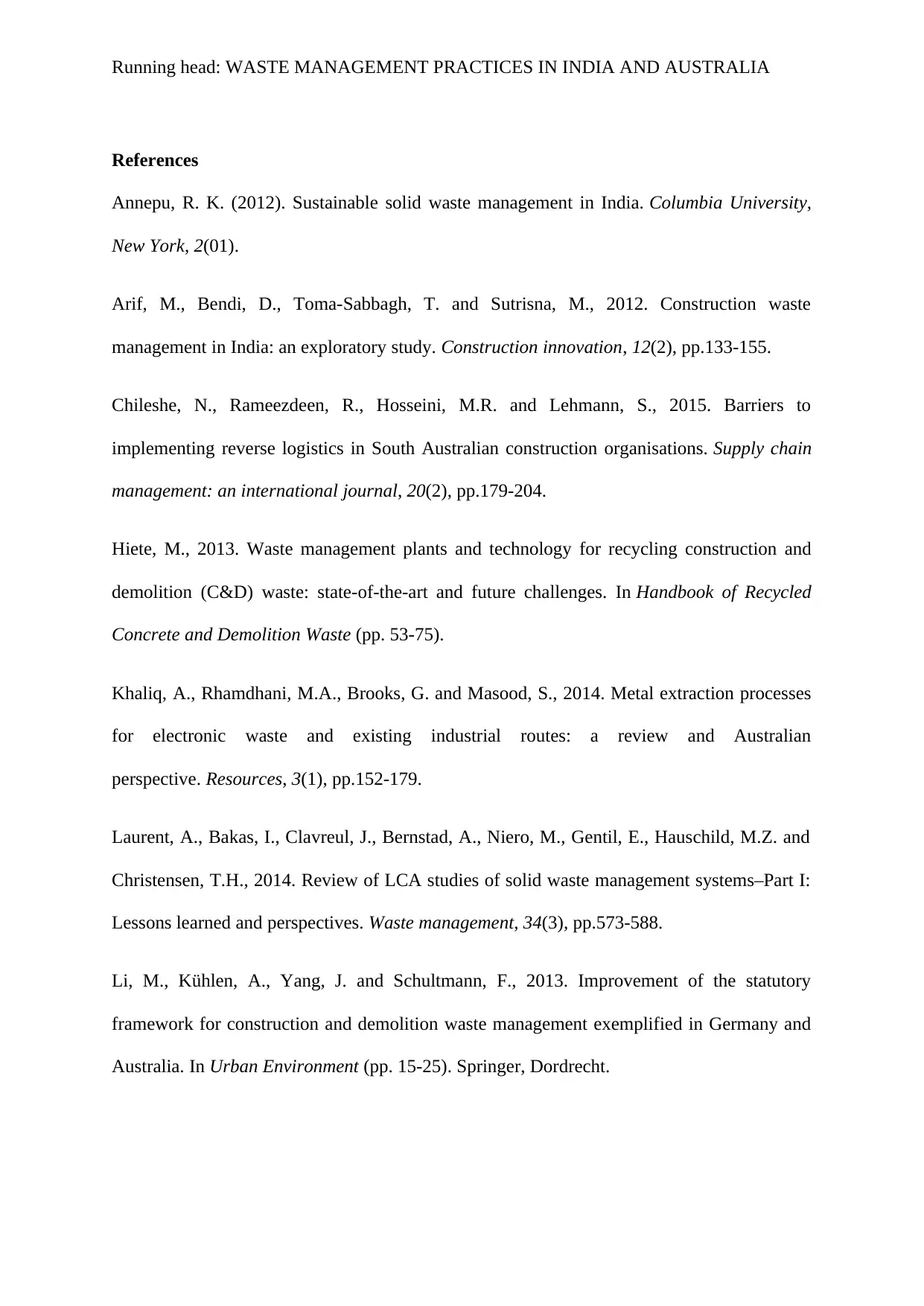
Running head: WASTE MANAGEMENT PRACTICES IN INDIA AND AUSTRALIA
References
Annepu, R. K. (2012). Sustainable solid waste management in India. Columbia University,
New York, 2(01).
Arif, M., Bendi, D., Toma-Sabbagh, T. and Sutrisna, M., 2012. Construction waste
management in India: an exploratory study. Construction innovation, 12(2), pp.133-155.
Chileshe, N., Rameezdeen, R., Hosseini, M.R. and Lehmann, S., 2015. Barriers to
implementing reverse logistics in South Australian construction organisations. Supply chain
management: an international journal, 20(2), pp.179-204.
Hiete, M., 2013. Waste management plants and technology for recycling construction and
demolition (C&D) waste: state-of-the-art and future challenges. In Handbook of Recycled
Concrete and Demolition Waste (pp. 53-75).
Khaliq, A., Rhamdhani, M.A., Brooks, G. and Masood, S., 2014. Metal extraction processes
for electronic waste and existing industrial routes: a review and Australian
perspective. Resources, 3(1), pp.152-179.
Laurent, A., Bakas, I., Clavreul, J., Bernstad, A., Niero, M., Gentil, E., Hauschild, M.Z. and
Christensen, T.H., 2014. Review of LCA studies of solid waste management systems–Part I:
Lessons learned and perspectives. Waste management, 34(3), pp.573-588.
Li, M., Kühlen, A., Yang, J. and Schultmann, F., 2013. Improvement of the statutory
framework for construction and demolition waste management exemplified in Germany and
Australia. In Urban Environment (pp. 15-25). Springer, Dordrecht.
References
Annepu, R. K. (2012). Sustainable solid waste management in India. Columbia University,
New York, 2(01).
Arif, M., Bendi, D., Toma-Sabbagh, T. and Sutrisna, M., 2012. Construction waste
management in India: an exploratory study. Construction innovation, 12(2), pp.133-155.
Chileshe, N., Rameezdeen, R., Hosseini, M.R. and Lehmann, S., 2015. Barriers to
implementing reverse logistics in South Australian construction organisations. Supply chain
management: an international journal, 20(2), pp.179-204.
Hiete, M., 2013. Waste management plants and technology for recycling construction and
demolition (C&D) waste: state-of-the-art and future challenges. In Handbook of Recycled
Concrete and Demolition Waste (pp. 53-75).
Khaliq, A., Rhamdhani, M.A., Brooks, G. and Masood, S., 2014. Metal extraction processes
for electronic waste and existing industrial routes: a review and Australian
perspective. Resources, 3(1), pp.152-179.
Laurent, A., Bakas, I., Clavreul, J., Bernstad, A., Niero, M., Gentil, E., Hauschild, M.Z. and
Christensen, T.H., 2014. Review of LCA studies of solid waste management systems–Part I:
Lessons learned and perspectives. Waste management, 34(3), pp.573-588.
Li, M., Kühlen, A., Yang, J. and Schultmann, F., 2013. Improvement of the statutory
framework for construction and demolition waste management exemplified in Germany and
Australia. In Urban Environment (pp. 15-25). Springer, Dordrecht.
Paraphrase This Document
Need a fresh take? Get an instant paraphrase of this document with our AI Paraphraser
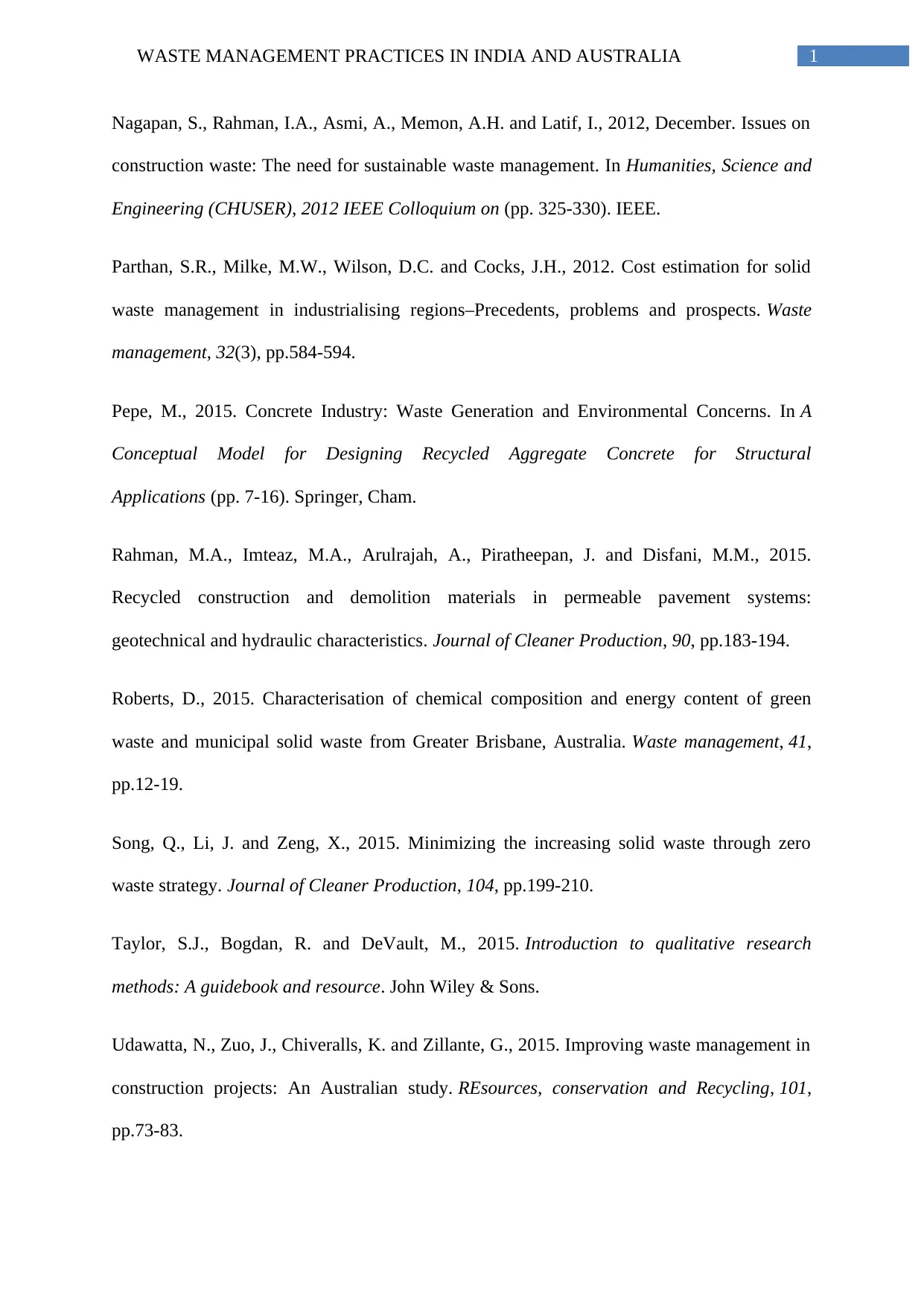
1WASTE MANAGEMENT PRACTICES IN INDIA AND AUSTRALIA
Nagapan, S., Rahman, I.A., Asmi, A., Memon, A.H. and Latif, I., 2012, December. Issues on
construction waste: The need for sustainable waste management. In Humanities, Science and
Engineering (CHUSER), 2012 IEEE Colloquium on (pp. 325-330). IEEE.
Parthan, S.R., Milke, M.W., Wilson, D.C. and Cocks, J.H., 2012. Cost estimation for solid
waste management in industrialising regions–Precedents, problems and prospects. Waste
management, 32(3), pp.584-594.
Pepe, M., 2015. Concrete Industry: Waste Generation and Environmental Concerns. In A
Conceptual Model for Designing Recycled Aggregate Concrete for Structural
Applications (pp. 7-16). Springer, Cham.
Rahman, M.A., Imteaz, M.A., Arulrajah, A., Piratheepan, J. and Disfani, M.M., 2015.
Recycled construction and demolition materials in permeable pavement systems:
geotechnical and hydraulic characteristics. Journal of Cleaner Production, 90, pp.183-194.
Roberts, D., 2015. Characterisation of chemical composition and energy content of green
waste and municipal solid waste from Greater Brisbane, Australia. Waste management, 41,
pp.12-19.
Song, Q., Li, J. and Zeng, X., 2015. Minimizing the increasing solid waste through zero
waste strategy. Journal of Cleaner Production, 104, pp.199-210.
Taylor, S.J., Bogdan, R. and DeVault, M., 2015. Introduction to qualitative research
methods: A guidebook and resource. John Wiley & Sons.
Udawatta, N., Zuo, J., Chiveralls, K. and Zillante, G., 2015. Improving waste management in
construction projects: An Australian study. REsources, conservation and Recycling, 101,
pp.73-83.
Nagapan, S., Rahman, I.A., Asmi, A., Memon, A.H. and Latif, I., 2012, December. Issues on
construction waste: The need for sustainable waste management. In Humanities, Science and
Engineering (CHUSER), 2012 IEEE Colloquium on (pp. 325-330). IEEE.
Parthan, S.R., Milke, M.W., Wilson, D.C. and Cocks, J.H., 2012. Cost estimation for solid
waste management in industrialising regions–Precedents, problems and prospects. Waste
management, 32(3), pp.584-594.
Pepe, M., 2015. Concrete Industry: Waste Generation and Environmental Concerns. In A
Conceptual Model for Designing Recycled Aggregate Concrete for Structural
Applications (pp. 7-16). Springer, Cham.
Rahman, M.A., Imteaz, M.A., Arulrajah, A., Piratheepan, J. and Disfani, M.M., 2015.
Recycled construction and demolition materials in permeable pavement systems:
geotechnical and hydraulic characteristics. Journal of Cleaner Production, 90, pp.183-194.
Roberts, D., 2015. Characterisation of chemical composition and energy content of green
waste and municipal solid waste from Greater Brisbane, Australia. Waste management, 41,
pp.12-19.
Song, Q., Li, J. and Zeng, X., 2015. Minimizing the increasing solid waste through zero
waste strategy. Journal of Cleaner Production, 104, pp.199-210.
Taylor, S.J., Bogdan, R. and DeVault, M., 2015. Introduction to qualitative research
methods: A guidebook and resource. John Wiley & Sons.
Udawatta, N., Zuo, J., Chiveralls, K. and Zillante, G., 2015. Improving waste management in
construction projects: An Australian study. REsources, conservation and Recycling, 101,
pp.73-83.
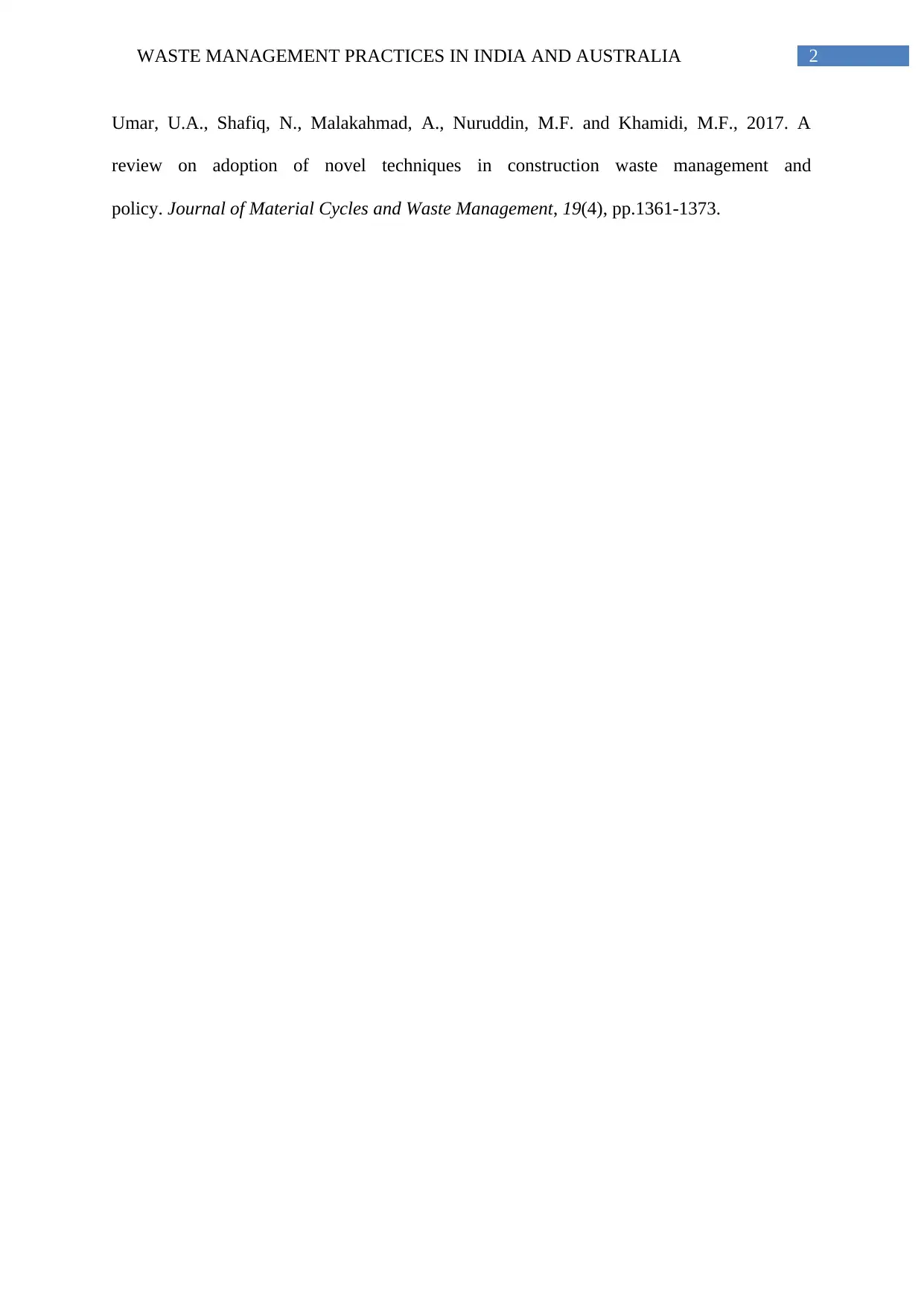
2WASTE MANAGEMENT PRACTICES IN INDIA AND AUSTRALIA
Umar, U.A., Shafiq, N., Malakahmad, A., Nuruddin, M.F. and Khamidi, M.F., 2017. A
review on adoption of novel techniques in construction waste management and
policy. Journal of Material Cycles and Waste Management, 19(4), pp.1361-1373.
Umar, U.A., Shafiq, N., Malakahmad, A., Nuruddin, M.F. and Khamidi, M.F., 2017. A
review on adoption of novel techniques in construction waste management and
policy. Journal of Material Cycles and Waste Management, 19(4), pp.1361-1373.
1 out of 15
Related Documents
Your All-in-One AI-Powered Toolkit for Academic Success.
+13062052269
info@desklib.com
Available 24*7 on WhatsApp / Email
![[object Object]](/_next/static/media/star-bottom.7253800d.svg)
Unlock your academic potential
© 2024 | Zucol Services PVT LTD | All rights reserved.





